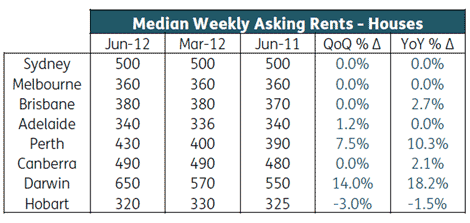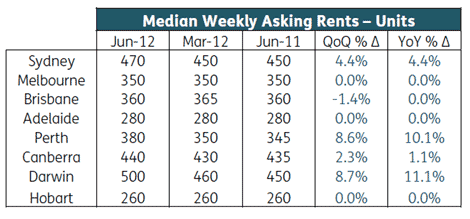Demand for inner-Sydney apartments drives up rents while Melbourne rents stagnate: APM

Sydney tenants are now paying almost the same weekly rent for apartments as they do for houses, according to June quarter rental report released by Australian Property Monitors (APM).
Over the three months to June, the median weekly asking rental for Sydney units increased by 4.4% to $470 while weekly rentals for houses remained unchanged at $500.
There was a $50 a week gap in the previous quarter. In June 2010 the gap was $40, with houses at $480 a week and units at $440 a week.
Sydney house rents have not changed in the year to June 2012.
APM attributed the gains in Sydney unit rentals in the June quarter to increasing demand by tenants for apartments, “with this rental market remaining highly competitive for prospective tenants, with low vacancy rates being recorded in most areas”.
“In the Sydney market, the price increases in units over the quarter reflect growing demand for this type of accommodation that typically is located closer to the CBD and provides more established urban infrastructure,” says Dr Andrew Wilson, senior economist at APM.
Click to enlargeClick to enlargeNationally median asking rents for houses rose over the quarter by 0.7% while units rose by 2.5% over the three months ending June 2012.
Perth was the other mainland capital city rental market that performed strongly, with house rents up 7.5% to $430 and unit rents up by 8.6% to $380.
Perth has also delivering strong returns for investors over the past 12 months, with year-on-year gross rental yields of 14.4% for houses and 15.2% for units.
In comparison, Sydney has returned a gross rental yield of 2% year-on-year for houses and 3.3% for units.
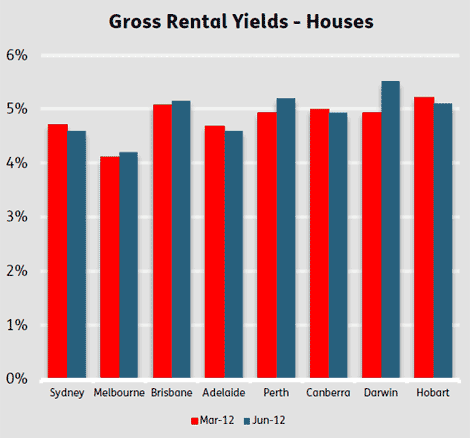
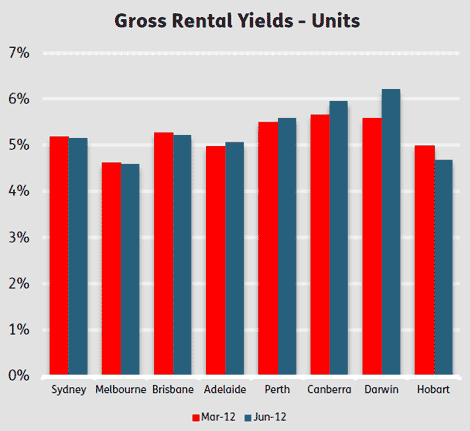
Despite the big rise in Perth rents, many tenants there would be better equipped to cope with rises than those in Sydney, where rents are already $70 higher for houses and $90 more for units than they are in the WA capital.
The most recent Australian Bureau of Statistics data shows WA's median gross weekly income was $1,466 in 2009-10, compared with $1,319 in New South Wales.
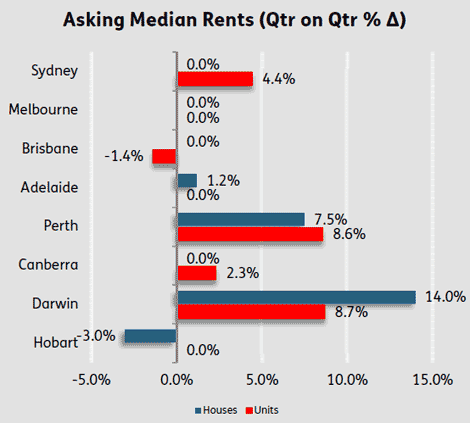
Among the smaller capital city rental market, Darwin house rents soared by 14% over the quarter to a median of $650, which is $150 more than they are in Sydney.
Darwin units increased by 8.7% over the June quarter to a median of $500, making them $30 more expensive than Sydney.
Darwin has delivered investors gross rental yields of over 20% for both houses and units year-on-year to June.
In contrast to Sydney and Perth, Melbourne remained a stagnant market for landlords and the most tenant friendly market of all the mainland capitals, with rental growth for both houses and units remaining subdued.
Weekly rentals for Melbourne house and units remain at the same price they were a year ago of $360 and $350 respectively.
In the closely watched Brisbane apartment market – there are over 40 new apartment projects underway in the inner-city suburbs – unit rents fell by 1.4% over the June quarter from $365 to $360 and are unchanged over the 12-month period.
Brisbane house weekly rents were unchanged over the quarter at $380 but up 2.7% over the 12 months to June
Canberra unit rents rose 2.3% over the quarter to a median of $440.
Outside of Sydney, particularly in Perth, Darwin and Canberra, Wilson says “ongoing shortages of accommodation and low levels of new supply are placing upward pressure on rentals, which can be expected to continue over the rest of 2012”.